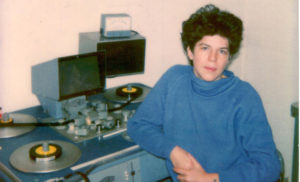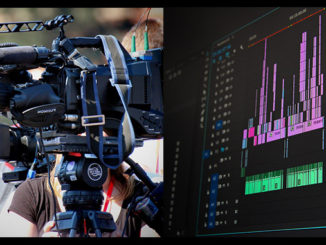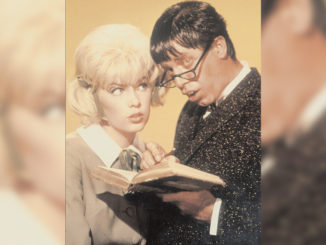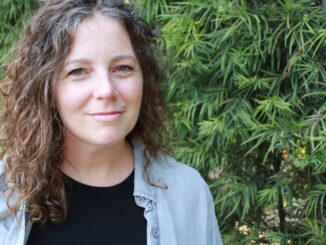
Su Friedrich knows filmmaking.
She has produced and directed 23 films and digital videos, won top prizes at international festivals, and had one of her films (“Sink or Swim”) chosen to be in the National Film Registry at the Library of Congress. She now teaches filmmaking at Princeton University.
But her years of experience did not prepare her for one thing: The general lack of acknowledgement for women editors throughout history.
So Friedrich has set about to remedy that with her website, Edited By, which documents the achievements of women who cut some of the most remarkable and acclaimed films in the history of cinema.
CineMontage asked Friedrich about how and why she made the site, and what she’s learned doing it:
Do you recall the initial impetus for the site? What was it?
I’ve been making films since 1978, and I usually do everything myself—the writing, the shooting, the directing (in the few cases I worked in a narrative mode) and the editing—so I know how critical editing is. I’ve also known that women editors have had a significant place in the evolution of cinema, but without knowing many details.
I teach film production courses at Princeton University. In January 2018, I came across a chapter about editing in a film history book in which every reference to a film mentioned the director’s name, not that of the editor. I planned on giving my students the text, and I didn’t think they should be reading it without learning who actually did the work that was being featured in a chapter about great editing.
I looked up each film on IMDb and discovered an astonishing number of women editors, and soon thereafter began doing the research which has resulted in this website. It isn’t meant be comprehensive or exhaustive, but rather to be the beginning of a survey that others will continue to expand upon.
The site salutes some early editors who are under recognized, such as Hettie Gray Baker, who worked with John Ford in the silent era. How did you accomplish the research for the site? What challenges were overcome in tracing all these early film histories?
I did research by starting with the world’s favorite resource: Google. There was a good amount of information I could glean from entries found there, and in many cases an entry would lead me to a book in which I might find a citation, a quote, an interview, or anything else. Renowned editors like Dede Allen and Thelma Schoonmaker were well-covered, but it was extremely difficult to find more than the skimpiest info about other editors, so I just kept digging and digging. One invaluable resource at the outset, especially in regards to the early editors, was the Women Film Pioneers website. I also grew to respect scholars working in an obscure area of their chosen field: Having nothing more than a two-line Wiki bio or an iMDB entry of an editor’s films was very frustrating, but I had such an intense desire to make these women visible that I did everything I could to accomplish that.
Moreover, I hired three former students of mine from Princeton — Lydia Cornett, Charlotte Maher Levy and Jane Pritchard — and a recent NYU grad, Lili Dekker, to start collecting materials for the main appendix. Another former student, Mike Jorgensen, did valuable research, too. Having had my own Google experience, I didn’t want a reader to get interested in an editor and then go hunting for further information, only to find the same two-line Wiki bio. So, beginning with the links I had found in doing the preliminary research, the researcher team hunted further to come up with as many really solid articles, video interviews, book chapter, and so on, that they could find. The Appendix ended up being forty-seven pages long.
What readers will find is pretty exciting, because in many cases when there might only be texts in foreign languages, like Russian, Swedish, Polish, French, German, Turkish, so I hired various people to translate those, so that one can read the original and can also read the texts in English. These have never been translated before, which means you can finally, for example, read Eisenstein’s poetic essay about his main editor, Esfir Tobak, or read a three-person interview with Marguerite Renoir, Suzanne de Troye and Marinette Cadix, or a long interview with Halina Ketling-Prugar, who edited many of Andrej Wajda’s films.
The site includes a companion film, “Edited By.” How were able to make this film? Was obtaining the clips a challenge? What about financing?
Making the companion film came at the end. I assumed that some readers wouldn’t be familiar with many of the films on the site since it covers so many decades and so many national cinemas, so I wanted to give a flavor of the great range of the work and make it possible for someone to see examples from a very slow, elegant kind of edit (for example, in Helen van Dongen’s work on “Louisiana Story“) to a fast and furious style (employed by Margaret Sixel on “Mad Max: Fury Road”) and all sorts of other approaches in between.

And now we’re back to Google, because I had almost no funding for the website, and none for the film, and I didn’t stop to think about getting any for the film, so I found whatever clips I could online and hoped they’d be good example of that woman’s work. In most cases, I got lucky. In others, I had to go further afield.
It wasn’t meant to be a “real film” – that is, a film which I would consider part of my body of work — but rather a sort of notebook or reference film which people could watch via the website.
I’m currently adding 25 more women to the main editors section and 21 more to the “filmmakers who always or sometimes edit” section, and then I’ll have to recut the companion film to include those new clips, at which point I might go in and replace some of the funkier clips with higher-res ones…. unless of course I decide that I should get back to my own film work instead.
You write: “The relative invisibility of editors―whether male or female―in contrast to the attention paid to writers, directors, cinematographers and composers, has been unwarranted and unjust. Editors make an essential contribution to the success or failure of a film.” Why do you think this is? Is it just auteur theory, or something else or additional?
I would attribute most of this to sexism, and I think male editors have been subjected to that same sexism because they work in an area of film production which isn’t seen as sufficiently macho – ugh – as compared to being a director. The notion that the director is the Big Boss flies in the face of reality. I’ve done some directing, and I know that the final outcome rests on your shoulders, and that you are the one who’s seen as being able to answer all the questions 24/7, and the one who can tell everyone else what to do and when to do it, but the reality is that there are so many extremely talented and hard-working people putting their everything into the film, and we need to stop thinking it’s all emanating from that one dude.
As for the auteur theory and its practitioners: We think of it as starting in France, right? Well, the fact is that there were three editors (Agnès Guillemot, Cécile Decugis, and Françoise Collin) who are credited with the editing of fifteen of Godard’s films (not working together, but on different films). In the case of Collin, I couldn’t find any portraits of her online. (There’s a famous French philosopher with the same name, so people sometimes use her photo mistakenly). I then queried the Cinémathèque Française, and they had nothing. I wondered how that was possible. Okay, so that was bad.
But in my new group of twenty-five, I’m adding three other French editors— Hélène Plemiannikov, who edited three major Bunuel films; Louisette Hautecoeur, who edited three other major Bunuel films; and Suzanne Baron, who, in addition to editing Jean Rouch’s most famous film, “Les Maitres Fous,” edited 14 films of Louis Malle—and I’m running into the same dead end. There’s not a picture to be had.
I have a French filmmaker friend. I asked her what was wrong with the French. She wrote back to say, “Interesting. These gaps reflect probably something about the relation of the filmmakers to their editors in France…. They are not really considered.”
So perhaps it was easy for the French to proclaim the existence of the auteur because they chose not to notice the other one: the editor.
The last point I would make about the indifference or disrespect shown to editors has to do with promotional materials. One of the wonderful aspects of the website are the film posters. On her page, each woman is represented by posters of several films she edited, and there’s a photo gallery in the back of the site where one can see them all. As I was finding and choosing them, I noticed how often the block of credits at the bottom of a poster would of course mention the usual (director, producers, actors) but it would often not mention the editor while almost always mentioning the composer! How is that possible?
What has been your greatest surprise in making the site? What types of reactions have you gotten from editors, the scholarly community, the general public?
As far as surprises go, there have been so many that I might say it was all a great surprise. Gloria Schoemann edited two hundred and twenty-one Mexican films! Beate Mainke-Jellighaus edited twenty Herzog films, both early narratives and late documentaries. Andrée Davanture edited almost all the canonical films by West African directors. Anne Bauchens was Cecil B. DeMille’s editor for forty years. Kelley Dixon edited twenty-seven episodes of “Breaking Bad.” Jolanda Benvenuti edited almost all of Rosselini’s films, and didn’t get screen credit for “Rome, Open City.”
And my most beloved surprise, which I learned at the outset and which became almost a chant for me?
“The Wizard of Oz” was edited by a woman!
And that woman was Blanche Sewell.
Meanwhile, who was the supervising editor at MGM for thirty-seven years (after being nominated for an Oscar for editing “Mutiny on the Bounty”) under whom Sewell worked when doing “Oz”?
That would be Margaret Booth.
As far as reactions go, editors (both male and female) who contacted me after the launch have expressed gratitude. They’ve known the experience of being invisible and appreciate being made visible.
The scholarly community? So far, a positive response, and some responses along the lines of, “Oh, I had no idea…!”. I do hope that the site leads film scholars to pay much more attention to this previously neglected area of scholarship.
And the general public has been enthusiastic, which is wonderful.





